
March 2014
U.S./European Union
Anti-Russia Drive Backfires
Self-Determination for Crimea – Oppose Sanctions!
Down with the Imperialist-Backed
Fascist/Nationalist Coup in Ukraine!
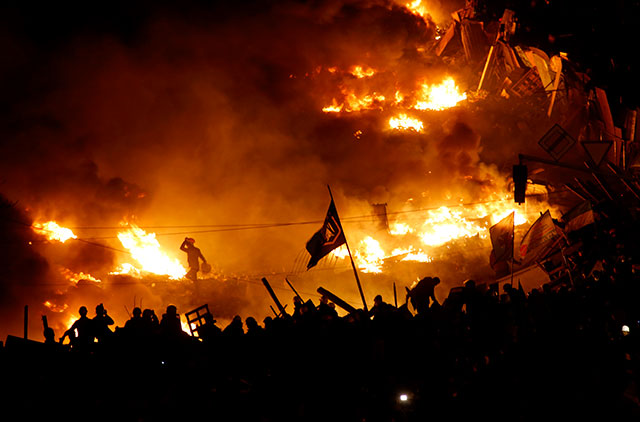
Fascist-led protesters set barricades aflame in Kiev's Independence Square, 20 February 2014. (Photo: Reuters)
Against Russian and Ukrainian Nationalism
and Anti-Semitism – For Workers Revolution!
MARCH 12 – Since late November, Ukraine has been convulsed by a right-wing nationalist and pro-imperialist mobilization culminating in a coup d’état that drove out the widely despised president Viktor Yanukovich and promptly split the country in two. Within hours of seizing power, the usurpers decreed that Russian would no longer be accepted as an official language, enraging the Russian-speaking east and south of the country. Russian president Vladimir Putin perceived the coup as a blow aimed at Moscow by the U.S., European Union and NATO backers of the mobilization, which it was. He struck back swiftly by taking over the Crimean peninsula, home of the Russian Black Sea fleet, to the applause of the majority Russian local population. Now the Western imperialists are sputtering, with the U.S. threatening economic sanctions and worse.
The talk in the media of a new Cold War underscores that the standoff over Ukraine is a byproduct of the destruction of the Soviet Union, a bureaucratically degenerated workers state. The 1991-92 counterrevolution led to impoverishment of the population in the post-Soviet states as capitalism devastated whole industries, women lost rights and interethnic hostilities were stoked. The 1917 Bolshevik Revolution led by Lenin and Trotsky brought down the Russian Empire of the tsars, a notorious “prison house of peoples,” by uniting the working people of different nationalities. In Ukraine, long enslaved by the Russian and Austro-Hungarian empires, the Bolsheviks achieved victory in a multi-sided civil war by uniting the struggle for social revolution with national liberation. As commander of the Red Army, Leon Trotsky issued an order of the day on 30 November 1919 calling for a “free and independent Soviet Ukraine.”
But contrary to the early Soviet policy of promoting Ukrainian language and culture, the bureaucracy that usurped political power under Stalin aggressively pursued Russification, having abandoned the struggle for world socialist revolution in favor of the illusion of building “socialism in one country.” In addition, Ukraine suffered several million deaths as a result of Stalin’s forced collectivization of peasant agriculture, and his purges hit Ukraine Communists harder than in any other Soviet republic. The Stalinist bureaucracy’s Russian chauvinism bred anti-Communist Ukrainian nationalism. Despite this heavy burden, the planned economy of the USSR provided the framework for a multinational state. Capitalism, in contrast, is based on the national state, and so counterrevolution was marked by a resurgence of reactionary nationalism.
As in Yugoslavia in the 1990s, another multinational bureaucratically deformed workers state ripped apart by the restoration of capitalist rule, in Ukraine today we are seeing “all the old crap” return, including the growth of violent fascist nationalist movements. And as always, the “democratic” Western imperialists are busily stoking the fires. In the new “government” in Kiev, cobbled together under U.S. and EU supervision, there are five ministers, including a deputy prime minister and the minister of defense, who come from or out of the Svoboda (Freedom) Party, a fascist outfit that blames Ukraine’s ills on a “Jewish-Russian mafia” and communists. Instead of setting off alarm bells, the presence of outright fascists backed up by neo-Nazi gangs was prettified as just “peaceful pro-democracy demonstrators” in the media.
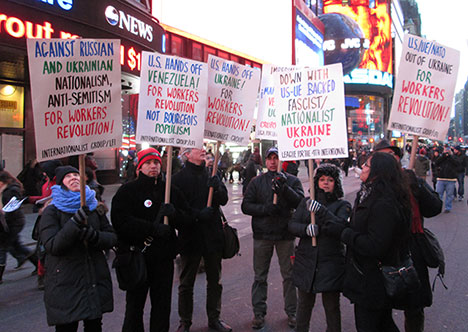 Internationalist Group/League for
the Fourth International at protest in New York City, February
27, demanding U.S. hands off Ukraine and Venezuela. (Internationalist photo)
Internationalist Group/League for
the Fourth International at protest in New York City, February
27, demanding U.S. hands off Ukraine and Venezuela. (Internationalist photo)Putin’s decisive takeover of Crimea without firing a shot has put the coup regime in Kiev in a bind, lacking the means to challenge it. It also won broad support in eastern Ukraine, with tens of thousands joining pro-Russian demonstrations in the industrial centers of Kharkiv, Donetsk and Luhansk. The Western imperialists so far have come up with nothing more than U.S. visa denials and pulling out of a Group of Eight (G8) summit scheduled for the Russian Black Sea resort of Sochi in June. Berlin would be hard put to do without energy supplies from Russia, which provides much of the natural gas that fuels German industry. But even if Putin’s aims are limited, particularly to protect the strategically located home port of Russia’s Black Sea fleet, imperialist ultimatums and provocative actions by Ukrainian nationalist and fascist bands could spark a shooting war.
Trotskyists recognize that ever since the fall of the USSR, the overwhelmingly Russian-speaking population of Crimea has chafed under Ukrainian rule, first proclaiming independence and then achieving a degree of autonomy in 1992. We support self-determination for Crimea and would oppose any attempt to prevent or undermine that, whether imperialist sanctions, military threats or cutting off supplies of water and electrical power. Marxists would also support demands for autonomy of Russian-speaking Odessa and eastern Ukraine, which rightly fear attacks by new rulers in Kiev, as well as for Crimean Tatars. However, a full-scale war between Russia and Ukraine would likely become a reactionary national conflict, with Russia driven by great power ambitions and Ukraine by anti-Russian nationalism backed by U.S./EU imperialism.
The League for the Fourth International calls instead for internationalist struggle to overthrow all the capitalist rulers through workers revolution. Meanwhile, we demand that the U.S. and European Union imperialists and their NATO military machine get out of Ukraine and call on working people to resolutely oppose any and all sanctions against Russia. The real instigators of the conflagration in Ukraine are the capitalist would-be masters of the world in Washington and Wall Street, in Brussels and Berlin. For the last two decades, they have sought to encircle Russia with client regimes, from the Baltic republics to Poland, Georgia and the big prize, Ukraine. And if the West succeeds in drawing Ukraine into its orbit, austerity “reforms” imposed by the International Monetary Fund will further impoverish the working people.
Fascists and Ukrainian Nationalists Lead Kiev Mobilization
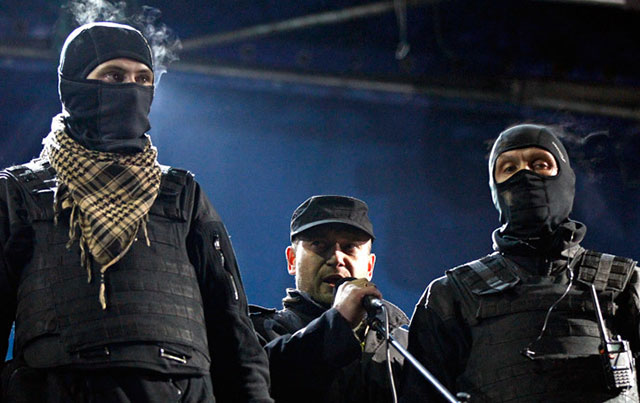
Dmytro Yarosh, leader of the neo-Nazi Pravy Sektor (Right Sector) storm troops, speaking at the Maidan, February 21. This fascist coup leader, now deputy defense minister of Ukraine, is planning a paramilitary National Guard. (Photo: Reuters)
The occupation of Kiev’s Independence Square, or Maidan, began in late November as a protest against Yanukovich’s decision to accept $15 billion in Russian aid rather than sign an agreement with the European Union that had been in the works for some time. Many of the protesters were from the western Ukraine, brought in by the busload. While some western Ukrainians naively hope that attachment to “Europe” would raise living standards, the protest leaders had a very different agenda. “Euromaidan,” as the occupation of the square was dubbed, was dominated from the outset by Ukrainian ultra-nationalists and outright fascists infused with hatred of Russians, Jews and communists and bent on provoking a crackdown. When police did attack, only to withdraw shortly afterwards, the provocateurs were emboldened, and the resulting injuries and deaths inflamed the public.
But while the Western press kept repeating its mantra about “peaceful pro-democracy demonstrators” set upon by a brutal regime, the leaders and hard core of several thousand protesters in the Maidan were anything but peaceful … or pro-democracy. In the run-up to and following the coup there has been an orgy of vicious Ukraininian nationalist, anti-Semitic and anti-communist attacks. The first Lenin statue was toppled as early as December 8. In an incident in January, neo-Nazi skinheads burned a Soviet flag while displaying a Celtic cross symbolizing “white power.” In the 24 hours following the February 22 coup, no less than 16 Lenin statues were torn down, making 25 in total. On February 23, the HQ of the Communist Party of Ukraine (KPU) was attacked, and the next day the house of the KPU leader was ransacked and torched.
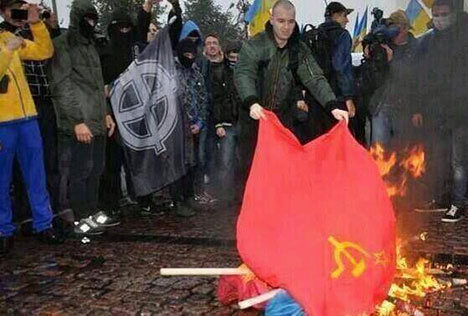 Ukrainian racists burn Soviet flag while
displaying Celtic cross, symbol of "white power" fascists in
Europe, January 2014.
Ukrainian racists burn Soviet flag while
displaying Celtic cross, symbol of "white power" fascists in
Europe, January 2014.At the same time, in the town of Styri near Lviv in western Ukraine a monument to the “Soviet Soldier” commemorating those who died fighting the German imperialist invaders in World War II was removed with a crane. In addition, several hundred offices of Yanukovich’s Party of Regions (PoR) were reportedly burned. This party, which won large majorities in Russian-speaking eastern and central Ukraine (and was supported in the parliament by the KPU), was seen as a representative of Russian influence in Ukraine. Since the victory of the coup, a Regions Party legislator was beaten in front of the Verkhovna Rada (Supreme Council). In the same post-coup session, a bill was introduced to outlaw the PoR and the KPU.
There have also been repeated attacks on Jews. Here is a partial list:
- On January 10, an Israeli-born Hebrew teacher, Hillel Wertheimer, was assaulted at his apartment building by four men who had followed him home from synagogue services.
- On January 17, a Jewish man, Dov Baar Glickman, was stabbed multiple times in the leg by three assailants who attacked him outside a synagogue in Kiev (Times of Israel, 18 January).
- On February 6, it was reported that a Holocaust memorial in the town of Oleksandria, in the Kirovograd district was desecrated, with swastikas and “Death to Jews” scrawled on it. (Bolshevik leaders Grigorii Zinoviev and Leon Trotsky both came from the area.)
- On February 20, leading Kiev rabbi Moshe Reuven Azman closed Jewish schools, told members of the Jewish community to avoid leaving their homes and urged them to “leave the city and even the country if possible,” out of fear of attacks (Maariv, 21 February).
- The rabbi’s fears were justified as immediately after the coup, on February 23, the Giymat Rosa Synagogue in Zaporizhia, near Dnepropetrovsk, was firebombed (Timenews.in.ua, 24 February).
The Israeli government has dismissed reports of anti-Semitic violence and instead highlighted the presence of several Israeli army veterans among the “fighting squads” of the anti-Yanukovich movement. Yet in Israel members of the Israeli Knesset called on the Netanyahu government to “prepare an emergency plan to bring Ukrainian Jews to Israel” (World Jewish Congress website, 27 February). This is not a contradiction, as Zionists going back to Ze’ev Jabotinsky (and David Ben Gurion) have a history of collaboration with Nazis and other anti-Semites to promote Jewish immigration to Palestine. (Israeli prime minister Netanyahu’s father was Jabotinsky’s secretary.)
Certainly many who demonstrated at the Maidan were incensed at their corrupt rulers, and no doubt many dreamed that “Europe” would bring them democracy and prosperity. But there is a concerted effort in the imperialist media (particularly by liberals, parroted by social-democratic leftists) to pooh-pooh the incontrovertible evidence of fascist and Ukrainian ethnic nationalist ultras in the leadership of the Kiev protesters and the post-coup government. Hear no evil, see no evil and speak no evil about Maidan are the orders from their imperialist commanders. Anyone befuddled by their cynical cover-up would do well to watch some of the many videos available online of brutal actions by the sinister Nazi gangs. For starters you can look at the compilation put together on the RT (Russia Today) TV Internet site at: http://rt.com/news/ukraine-nationalists-fears-video-674/.
You can see there how in mid-February masked thugs in combat fatigues and black boots from the Svoboda Party manhandle activists from the group “For a Clean Kiev,” mostly women, who came out to sweep up debris, collect trash and dismantle barricades; how the fascist goons knock down young men and beat them bloody with batons and baseball bats, repeatedly kicking them in the head; how they throw lighted Molotov cocktails and fire rockets at the defenseless activists. You can see squads of Pravy Sektor (Right Sector) goons giving Nazi-style stiff-arm salutes as they chant “Ukraine for the Ukrainians” and shout “Glory to the nation! Death to enemies!” You can see “SS” inscribed on their shields as they wield potentially lethal spiked flails at women and strike martial poses with their revolvers.
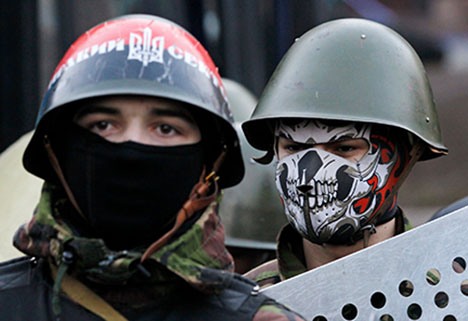 Fascist shock troops of Pravy Sektor in the
Maidan, February 20. Note helmet painted with red-and-black
flag of Stepan Bandera’s UPA which fought together with Nazi
SS against Soviet Red Army. (Photo: Reuters)
Fascist shock troops of Pravy Sektor in the
Maidan, February 20. Note helmet painted with red-and-black
flag of Stepan Bandera’s UPA which fought together with Nazi
SS against Soviet Red Army. (Photo: Reuters)You can hear them explain: “National Socialist themes are popular amongst some of us. A clean nation. Not like under Hitler but in our own way, a little bit like that.” Asked about Russian speakers in eastern Ukraine and Crimea, they reply: “Those who like Russia, let them move to Russia. Ukraine will be just for Ukrainians.” A spokesman for C14, an anti-Semitic youth group linked to Svoboda, tells BBC TV that, “Many ethnic groups have control of business structures, some economic, some political.” Which ethnic groups? “Russians, and Jews and Poles.” Also active in the Maidan were the neo-Nazi street fighters of Patriot of Ukraine; the racist White Hammer; Trizub (Trident, named after Ukraine’s coat of arms) which sponsors military training of youth; the Congress of Ukrainian Nationalists and Ukrainian Platform Sobor. The purpose of these armed gangs is to terrorize any opposition.
“Mainstream” bourgeois apologists for the Maidan mobilization, echoed by some leftists, generally admit what by now is impossible to deny – the prominent participation by anti-Semitic ethnic nationalists and fascists in the mobilizations – but seek to minimize it, claiming that they represent only a minority of the protesters, etc. A German academic who teachers in Kiev, Andreas Umland, earlier argued that “Svoboda has been and probably will remain a minor Ukrainian political force,” while saying it was a “strategic mistake” for other protesters to take up the ultra-nationalists’ slogans (Kyiv Post, 28 December 2013). In January he circulated a petition by academics saying “the heavy focus on right-wing radicals in international media reports” is “unwarranted and misleading.” More recently (AFP, 1 March), Umland argued that Svoboda’s influence was “hyped” and Pravy Sektor was “overrated.”
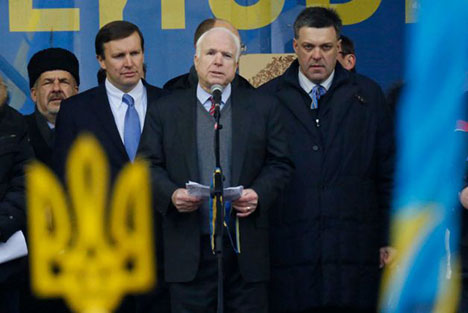 Republican senator John McCain (center) and
Democratic senator Chris Murphy on stage at Kiev's Maidan
together with Oleh Tyahnibok, leader of the fascist Svoboda
party, 15 December 2013. Anti-Semitic anti-communist Tyahnibok
rails against “Muscovite-Jewish mafia,” but now he is embraced
by U.S. imperialism. (Photo:
Dmitry Lovetsky/AP)
Republican senator John McCain (center) and
Democratic senator Chris Murphy on stage at Kiev's Maidan
together with Oleh Tyahnibok, leader of the fascist Svoboda
party, 15 December 2013. Anti-Semitic anti-communist Tyahnibok
rails against “Muscovite-Jewish mafia,” but now he is embraced
by U.S. imperialism. (Photo:
Dmitry Lovetsky/AP)Even if this were true, which it is not, there can obviously be no common action with fascists and racists, they must be smashed. Underestimating the threat of neo-Nazis, white racists and anti-Semites can be fatal. And in fact, Svoboda and Pravy Sektor were top leaders of the Maidan occupation. One of the three main spokesmen was Svoboda leader Oleh Tyahnibok, a member of parliament who in 2004 gave a speech complaining that Ukraine was run by a “Muscovite-Jewish mafia.” Later he called on the government to “stop the criminal activity of organized Jewry.” Last year, Tyahnibok was barred from entering the United States citing his virulent anti-Semitism. But in December, Republican senator John McCain appeared on the platform in the Maidan with this Jew-hater, and U.S. undersecretary of state Victoria Nuland met with him.
No. 2 in the Svoboda hierarchy is Yuri Mykhalchyshyn, who openly promotes fascism. Mykhalchyshyn founded the organization as the Social-National Party in 1991, mimicking the name of Hitler’s National Socialists. He calls the Holocaust “a bright episode in European civilization,” founded a think tank originally called the “Joseph Goebbels Political Research Center,” published a volume of tracts by Italian, German and Ukrainian fascists, dresses in skinhead neo-Nazi style and leads torchlight parades behind banners with SS symbols. If Tyahnibok is mainly anti-Semitic, Mukhalchyshyn is particularly anti-Russian, referring to Ukrainians from east of the Dniepr River as “Asiatic dogs.” Last October he introduced a bill to the Rada to require public employees to speak and write Ukrainian or be fired.1
No longer minor players in Ukrainian politics, Svoboda and other rightist ethnic nationalists managed to get their themes and chants taken up by the Maidan protests. And having played a key role in the coup, many of these ultra-rightists are now prominent in the post-coup government. Svoboda has deputy prime minister and economics minister Oleksandr Sych, who earlier introduced a bill to ban all abortions, including in cases of rape; ecology minister Andriy Makhnyk; agriculture minister Ihor Shvaiko; and the important position of prosecutor-general, Oleh Makhnitsky. Education minister Serhiy Kvit is a “former” member of Svoboda, as is Andriy Parubiy, in the key post of head of the national security and defense council, in charge of the military, while the deputy chief is Dmytro Yarosh, the top leader of Pravy Sektor.
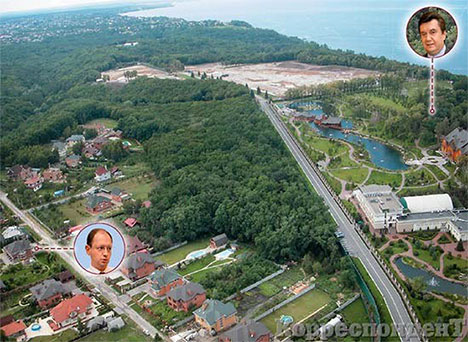 Imperialist media had a field day with photos of
ousted Ukrainian president Yanukvich's lavish estate (top
right). But new “prime minister” Yatsenyuk installed by
fascist-led, imperialist-backed coup has a villa (lower left)
in the same upscale neighborhood. No petting zoo with rare
giraffes, though.
Imperialist media had a field day with photos of
ousted Ukrainian president Yanukvich's lavish estate (top
right). But new “prime minister” Yatsenyuk installed by
fascist-led, imperialist-backed coup has a villa (lower left)
in the same upscale neighborhood. No petting zoo with rare
giraffes, though. “F**k the EU!”: U.S. Diplomats Select Ukraine Premier
A peek behind the curtain of imperialist machinations over Ukraine was provided when someone leaked part of a conversation between U.S. Ambassador to Ukraine Geoffrey Pyatt and U.S. Deputy Secretary of State Victoria Nuland and posted it on YouTube on February 6. Given the past year of revelations about global NSA snooping, with the U.S. listening in on everyone including leaders of top American allies like Germany, it was indeed poetic justice when the snoopers themselves had their conversations blasted over the Internet.
In their not-so-secure chat, Pyatt and Nuland decide that Klitschko should not be a member of a future government, which they want formed around Yatsenyuk, as in fact occurred a few weeks later. If their references to “Klitsch” and “Yats” in this dialogue make you think of nicknames for household pets, you are not far off the mark. Nuland further decrees “what he [Yatsenyuk] needs is Klitsch and [fascist Svoboda leader] Tyahnibok on the outside.”
After deciding on the marching orders for the Ukrainians and proposing a UN cover to deliver them, Nuland adds: “And you know, fuck the EU.” Nuland’s language about the European Union is simply an crude expression of imperialist rivalries. The U.S. not only wanted to move faster while the Europeans wanted more discreet “regime change,” they also preferred different puppets. Klitschko, the former heavyweight boxer but political lightweight, was the German candidate, heavily backed by the Christian Democrats’ Adenauer Foundation.
The media focused on the “undiplomatic” language when the real story is how the U.S. was caught organizing the future deployment of Ukrainian politicians on the political chessboard and even micromanaging their scheduling. And after the putsch, Ukraine now has an “interim government” headed by “Yats” and minus “Klitsch.” So much for “Ukrainian sovereignty”!
This cabinet is now preparing to impose the draconian economic “reforms” dictated by the International Monetary Fund, in exchange for a few billion euros and dollars which won’t begin to cover the devastation. According to a draft document obtained by the Ukrainian edition of the Russian business paper Kommersant, plans are afoot to cut pensions in half. This will no doubt soon be followed by demands for more privatizations, and (especially with the end of Russian discounts) an end to natural gas subsidies, which have kept Ukrainians from freezing to death in the frigid winters. Wage cuts won’t be far down the line, although much of that may be accomplished by a drastic devaluation of Ukraine’s currency, the hryvnia, by 50% or more (it is already down 25% since December), which will send prices for basic necessities soaring.
Meanwhile, the coup regime has named prominent “oligarchs” to be unelected rulers of the eastern Ukrainian provinces. Sergei Taruta was appointed governor of Donetsk and Ihor Kolomoysky governor of Dnipropetrovsk. Taruta owns ISD, with major steel mills in Ukraine and also the largest steelworks in Poland (Huta Czestachowa) and Hungary. Kolomoysky is Ukraine’s third-richest man according to the Forbes’ billionaires list as head of the Privat Group conglomerate controlling banks, airlines, iron and steel mills, oil and chemical plants, and more. The new powers in Kiev are apparently hoping that with the Party of Regions out of the picture, Russian-speakers in eastern Ukraine will have confidence in these robber barons who claim to be providing jobs (after looting the remnants of the collectivized Soviet economy).
So this is the “democracy” promoted by U.S. and EU imperialism: the naked dictatorship of monopoly capital.
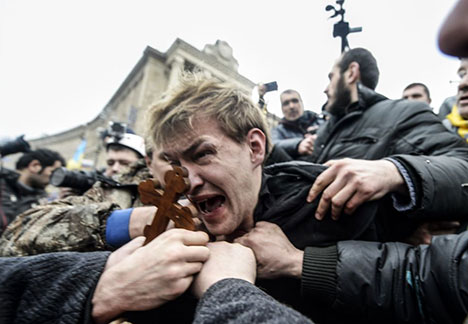 No repression under coup regime? State
Department lies. Right: Communist Party leader of Lviv
tortured with cross in Maidan, followed by much worse. (Photo: AFP)
No repression under coup regime? State
Department lies. Right: Communist Party leader of Lviv
tortured with cross in Maidan, followed by much worse. (Photo: AFP)But according a U.S. State Department paper, there have been “no incidents of attacks on churches.” The firebombing of a synagogue doesn’t count? There has also supposedly been “no retribution against political opponents.” So what about the assault on Party of Regions deputy Vitaly Grushevsky outside the Rada? What about the banning of the Communist Party and Party of Regions in the districts of Ivano-Frankivsk, Ternopil and Poltava? Or the attack on the KPU office in Zaporozhia, or the burning of KPU offices in Kiev, Dnipropetrovsk and Kryvy Rih? Or the attack on the secretary of the Communist Party in Lviv, Rotislav Vasilko, who was smashed in the face with a cross and tortured in Mariinsky Park, driving needles under his fingernails, beating him with clubs, puncturing a lung, breaking his nose and three ribs, cracking his skull and threatening to kill him, his wife and children?
“Calm has returned to Kiev,” declares the State Department.
It recalls German Communist Rosa Luxemburg’s famous January
1919 article, “Order Reigns in Berlin,” bitterly mocking the
claims of the social-democratic government and bourgeois media
after the former smashed the leftist opposition. Hours later,
she and Karl Liebknecht were arrested and murdered on
government orders by the fascist thugs of the Freikorps.
The Return of Banderaite Fascism
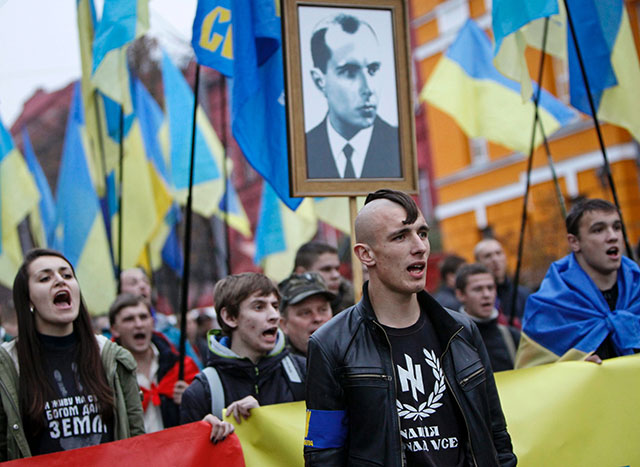
Svoboda marchers with Nazi symbol carry photo of Stepan Bandera in October 2013 rally. (Photo: Reuters)
All the ultra-rightist groups embrace fascist nationalist Stepan Bandera, whose wing of the Organization of Ukrainian Nationalists (OUN-B) and its Ukrainian Insurgent Army (UPA) engaged in guerrilla war against the Soviet Red Army during World War II in alliance with the German imperialist invaders. Bandera worked out of Krakow, HQ of the German administration of occupied Poland. He trained mobile squads in German intelligence (Abwehr) military camps, helped form the Ukrainian Nachtigall and Roland battalions to fight under German command, and received 2.5 million Reichmarks for anti-Soviet subversive activities. When relations between the Nazis and the UPA soured, Bandera was “kept in reserve” in the Sachsenhausen concentration camp, but was then released in 1944 to fight the advancing Soviet Red Army.
In later years, apologists for Bandera have tried to claim that he also fought the Nazis. This is a sheer invention, and those who propagate it are apologists for fascism. When German troops invaded Ukraine in June 1941, the OUN leader proclaimed a Ukrainian state whose founding document declared that it “will work closely with the National-Socialist Greater Germany, under the leadership of its leader Adolf Hitler.” Bandera’s deputy and “prime minister” of the phantom state Yarovlav Stetsko, who is honored in eastern Ukraine today, called for “the destruction of the Jews” by “bringing German methods of exterminating Jewry to Ukraine.” In 1943-44, the UPA massacred over 90,000 Poles and thousands of Jews. When Bandera resumed the struggle in 1944, he set up an office in Berlin while the Germans supplied UPA units by air.
 Stepan Bandera (center) wearing
uniform of German Abwehr (military intelligence) with order
of merit 2d class with swords. Photo probably from 1941.
Stepan Bandera (center) wearing
uniform of German Abwehr (military intelligence) with order
of merit 2d class with swords. Photo probably from 1941.When Lviv was occupied by the Germans on 30 June 1941, there was a pogrom lasting three days, organized by the SS Einsatzgruppen (paramilitary death squads) but mainly carried out by the Nacthigall Battalion under Roman Shukhevych, the future commander of the UPA, and by Bandera’s OUN directly. Up to 10,000 Jews and Communists were slaughtered in the most hideous manner. A second pogrom in Lviv took place three weeks later, called the “Petlyura days” (after anti-Soviet Ukrainian hetman Symon Petlyura), mainly by Ukrainian nationalist squads, killing another 2,000 Jews. Later, following a 1943 decision by the OUN-B to drive out all non-Ukrainians, the UPA systematically carried out massacres of Poles in the Volhynia region (40,000 to 60,000 killed) and eastern Galicia around Lviv (30,000-40,000 killed).
The Banderaite OUN were Nazi-allied fascists just as were the supporters of the puppet dictator Tiso in Slovakia, the Croatian Ustasha or the Romanian Legionnaires. Moreover, while today Ukrainian nationalists try to disguise Bandera’s anti-Semitism and collaboration with the Hitlerites, they hail the Nazi Waffen-SS Galizien Volunteer Division, which many UPA members joined. In April 2011, Svoboda held a march of several thousand in Lviv on the anniversary of the founding of the Division. Fortunately, the Galizien SS was destroyed and most of its troops killed in July 1944 at the battle of Brody as Marshall Konev’s First Ukrainian Front of the Soviet Red Army liberated Lvov (now Lviv). Unfortunately though, 2,000 survivors joined the Banderaite UPA which continued unsuccessful anti-Soviet guerrilla actions into the 1950s.
When the Social-National Party of Ukraine was founded in 1991, it chose as its symbol a mirror image of the Wolfsangel, or wolf hook, a swastika-like design used by several Nazi SS Divisions and which has been used by neo-Nazi groups since World War II. Although the SNPU changed its name to Svoboda in 2004 and tried to soften its image along the lines of the National Front in France, the Freedom Party in Austria, the NPD in Germany and Jobbik in Hungary, all fascist parties that strike a right-wing populist pose on social issues (e.g., against immigrants), it kept the Wolfsangel. During the recent mobilization, Svoboda squads sported yellow armbands with the Nazi symbol. Svoboda also promoted Bandera as a national hero, including a Nazi-style torchlight march in Kiev on January 1 to celebrate the Ukrainian fascist’s birthday.
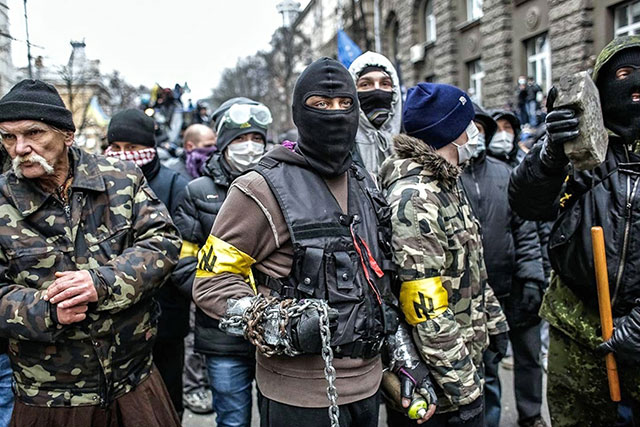
Fascist thugs of Svoboda wear swastika-like "wolf hook" arm bands during riots in Kiev, 6 February 2014.
Ultra-rightist Ukrainian nationalists have been able to exploit the Bandera mythology largely because it was shared with the “mainstream” bourgeois parties out of common hatred for the Soviet Union. In his infamous 2004 anti-Semitic speech, Svoboda leader Tyahnibok praised the OUN-UPA for having fought the “Muscovites, Germans, Yids and other scum, who wanted to take away our Ukrainian state!” Yushchenko during his presidency set up a Museum of Soviet Occupation which presented a sanitized patriotic version of the UPA, and declared Bandera and Shukhevych, the organizer of the Lviv pogrom, national heros. So when fascists Svoboda and Pravy Sektor marched along with other Ukrainian ultra-nationalists with the red-and-black flag of Bandera’s UPA (symbolizing blood and earth, Blut und Boden in Nazi language) and chanted “Glory to the nation, Glory to its heroes. Death to its enemies,” it fit right in at the Maidan.
But this Ukrainian nationalist iconography whitewashing Nazi collaborators repulsed many in the Russian-speaking east who had parents and grandparents who fought in the Soviet Red Army against the German invaders and later against the Bandera bands. When they saw the Banderaite flag waving at the Maidan, they feared those protests were directed against them. And when the victorious fascists and ultra-nationalists immediately passed a law banning the use of Russian in official business, their fears were confirmed. That also confirmed the academic Umland’s worry that praising Bandera’s UPA could alienate “millions of eastern and southern Ukrainians” who regard them as “despicable traitors in the Soviet Union’s nations’ joint struggle against fascism,” and could lead to “tearing the young Ukrainian state apart.”
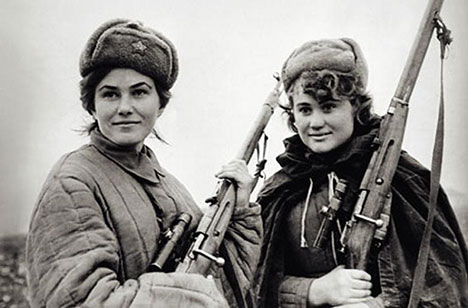 While
Ukrainian nationalists glorify Nazi collaborator Bandera, we
hail Ukrainian Soviet partisans who joined with Red Army in
defeating the fascist scum. Shown here are members of the
Sydir Kovpak partisan detachment which fought Bandera's UPA
and raided Wehrmacht forces throughout western Ukraine,
inflicting heavy casualties.
While
Ukrainian nationalists glorify Nazi collaborator Bandera, we
hail Ukrainian Soviet partisans who joined with Red Army in
defeating the fascist scum. Shown here are members of the
Sydir Kovpak partisan detachment which fought Bandera's UPA
and raided Wehrmacht forces throughout western Ukraine,
inflicting heavy casualties.Svoboda, Pravy Sektor and the other fascist and ultra-nationalist groups that have played a leading role in the Maidan protests are not a uniquely Ukrainian phenomenon. Significant fascist movements have appeared in different parts of Europe in the wake of counterrevolution in the USSR and former Soviet bloc, and particularly in recent years as a reflection of the capitalist economic crisis that exploded in 2008 and continuing mass unemployment. This has become a mass movement in countries where the bourgeoisie has whipped up hatred of immigrants and national minorities, such as Jobbik in Hungary, the National Front in France and Golden Dawn in Greece. Appeals for ethnic purity are an essential ingredient in this hysteria, along with the usual anti-communism of fascist movements, which has been particularly strong in Ukraine.
Svoboda went from being a minor political actor to a major electoral party beginning in 2009, when it received over a third of the votes in a regional election, and in 2012 when it won 10% of the vote in parliamentary elections and more seats than the KPU in the national Rada despite having significantly less votes. Many of those who voted for Svoboda were working-class, angry over unemployment and the vast corruption of Ukraine’s political leaders. But the base of the fascists is, as always, among the enraged petty bourgeoisie who want to bludgeon their way into power. What they have achieved is for one faction of the traditional capitalist politicians to replace another, which may not satisfy their base. That could produce discontent in western Ukraine, which will likely be the first region to feel the brunt of EU-dictated austerity. While this could provide an opening, to build a class opposition to all the “oligarchs” requires above all revolutionary internationalist leadership.
Imperialists Stirring the Ukrainian Cauldron
Ukrainian president Yanukovich refused to sign off on the EU pact no doubt in part because of pressure from Moscow, but also because the deal included brutal austerity measures dictated by the IMF which he calculated would provoke massive discontent and lead to his downfall. So instead he faced a revolt by those who claimed he had dashed their dreams of joining Europe. This came largely from the western Ukraine where anti-Russian nationalism has always been strong. Once the fascists and ethnic nationalists gained leadership of the protests early on, you had a combustible mixture. Throw in the match of a deeply corrupt ruler anxious to protect his loot, periodically cracking down but then backing off out of fear of a civil war, and you got an explosion.
But what lay behind this outcry for a pact that would mean a drastic fall in living standards? In addition to Ukrainian nationalism there was the blowback from the failure of the so-called “Orange Revolution” of December 2004, which once before threw out Yanukovich as president on claims of election fraud. This was one of a series of “color revolutions” (such as Georgia’s “Rose Revolution” of 2003) sponsored by the U.S. working through various “non-governmental organizations” (NGOs). (See our article “U.S.-Sponsored Coup d’État in Ukraine,” The Internationalist No. 20, January-February 2005.) But the “orange” governments of Viktor Yushchenko followed by the filthy rich Yulia Tymoshenko proved to be every bit as corrupt as Yanukovich, who was elected in 2010, mostly with votes from eastern and southern Ukraine.
The same imperialists who were behind the 2004 “revolution” are active today, and the main driving force has been “centrist” U.S. Democrats. “Neo-conservatives” around George W. Bush talked of spreading “democracy” at gunpoint by overthrowing formerly U.S.-allied regimes in Islamic countries (the Taliban in Afghanistan, Saddam Hussein in Iraq), while ensuring U.S. control of Near East oil. The Democrats focused on securing U.S. world dominance, notably by preventing post-Soviet Russia from becoming a “superpower.” This was the strategy of Zbigniew Brzezinski, the Polish-born national security advisor of Democratic president Jimmy Carter, laid out in his books The Grand Chessboard: American Primacy and Its Geostrategic Imperatives (1997) and The Choice: Global Domination or Global Leadership (2004).2
Control of Ukraine is key to this operation. In an article, “A Geostrategy for Eurasia,” in Foreign Affairs (September-October 1997), Brzezinski argues that Russia should be induced to give up the “futile effort to regain its status as a global power,” and should be carved up into “a European Russia, a Siberian Republic, and a Far Eastern Republic.” To bring this about, he wrote, the U.S. should ensure that “the newly independent post-Soviet states are vital and stable,” adding: “A sovereign Ukraine is a critically important component of such a policy….” It should be recalled that Brzezinski boasted in a 1998 interview with the French magazine Nouvel Observateur about how he and Carter secretly began aiding the Islamic reactionary mujahedin in Afghanistan in 1979 with the aim of “drawing the Russians into the Afghan trap.”
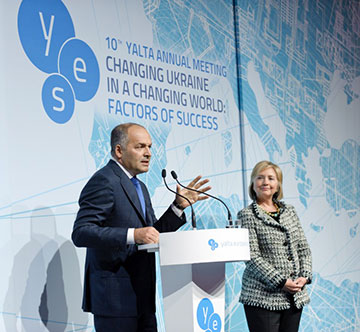 Ukrainian oligarch Victor Pinchuk introduces
Hillary Clinton as "superstar" at Yalta European Strategy
conference in Yalta, September 2013. (Photo: YES 2013)
Ukrainian oligarch Victor Pinchuk introduces
Hillary Clinton as "superstar" at Yalta European Strategy
conference in Yalta, September 2013. (Photo: YES 2013)In carrying out the Democrats’ strategy in Ukraine, the drive to ally with the European Union has been pushed by an annual Yalta European Strategy (YES) conference held at the site of the World War II summit of Roosevelt, Churchill and Stalin. The confabs are sponsored by the No. 2 Ukrainian oligarch, Victor Pinchuk, the son-in-law of former Ukraine president Leonid Kuchma, and have included such imperialist A-list luminaries as former U.S. presidents Bill Clinton and George Bush the elder, Henry Kissinger and ex-IMF chief Dominique Strauss-Kahn. Pinchuk has donated some $13.1 million to the Bill, Hillary & Chelsea Clinton Foundation, and at the latest YES meeting last September introduced Hillary Clinton, who “delivered a keynote address about strengthening Ukraine’s economic ties to the West” (New York Times, 13 February).
So two months before the protests break out in Kiev, the Clintons are in Yalta pushing the EU-integration agenda. From the beginning, Kiev’s Maidan was crawling with imperialist agents and NGOs (see box). One of the key players in the U.S. imperialists’ “Operation Maidan,” Deputy Secretary of State for European and Eurasian Affairs Victoria Nuland told a meeting in Washington on December 13 that she was just back from her third visit to Ukraine in five weeks. In addition to her famous phone call, she spoke from the stage to anti-government protesters and handed out food in the Maidan! Nuland, who was appointed by then secretary of state Clinton, was earlier Principal Deputy National Security Advisor to Vice President Dick Cheney, and is married to Robert Kagan, co-founder of the neo-con Project for a New American Century.3
Ukraine on the Auction Block As NGOs Prepared Coup in Kiev
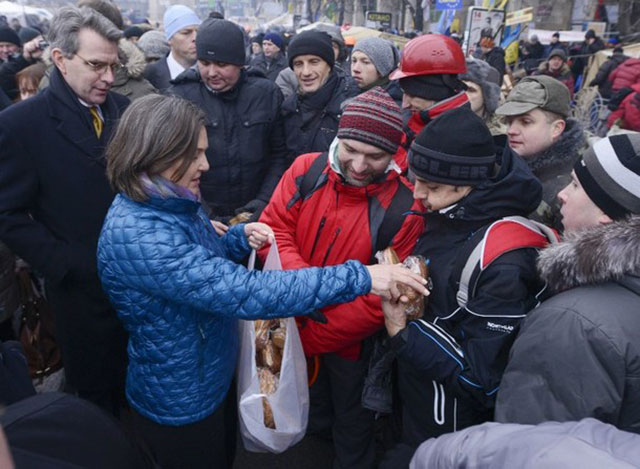
U.S. ambassador to Ukraine Geoffrey Pyatt (left) and Assistant Secretary of State Victoria Nuland pass out cakes to anti-government protesters in the Maidan, 10 December 2013. (Photo: Andrew Kravchenko/AFP)
At a December 13 meeting of the U.S.-Ukraine Foundation in Washington, Deputy Secretary of State Victoria Nuland declared that “we’ve invested over $5 billion to assist Ukraine” to “build democratic skills.” So who got the dough? While Washington stonewalls in the face of Moscow’s charges that it was bankrolling Maidan, it is possible to track some of it down. The New York Times (9 December 2013) refers to “Svitlana Zalishchuk, one of a small coalition of civic organizers who have been leading the protests from behind the scenes….” Zalishchuk used to be press secretary to the chief of staff of President Yushchenko, Oleh Rybachuk, and with him co-founded the NGO Centre UA, which has a U.S.-funded project “Platform for Analyzing the European Integration Policy of Ukraine.”
Centre UA reports grants from the U.S.’ National Endowment for Democracy (NED), set up to replace funding by the CIA when that was exposed in the 1970s. It also gets a bundle from the Omidyar Network, set up by the founder of eBay, the Internet auction site. So now it’s “Who’ll be the highest bidder for Ukraine? Do I hear $5 billion? $15 billion? $35 billion? Sold to the IMF, EU and USA! Next up is Venezuela. It’s a steal, with great cash flow from oil revenue, beauty queens and more. Who will start the bidding? NED?”
But the largest single donor to Centre UA is an outfit called Pact Inc., which turns out to be a conduit to “facilitate the distribution of small USAID grants to PVOs” (private and voluntary organizations). Centre UA has also gotten seed money from the International Renaissance Foundation, part of George Soros’ Open Society constellation of foundations. And Soros’ IRF has been up to its neck financing Maidan groups, notably Spilna Sprava (Common Cause), which occupied several government ministries in late January and was accused by “moderates” and even the fascist Svoboda of staging provocations.
So here you had top American and European officials openly embracing fascists and speaking from a platform of a protest in Kiev’s main square whose declared purpose was to overthrow the Ukrainian government. You had the U.S. pumping in literally billions of dollars to fund anti-government NGOs. It was the height of imperialist arrogance. If Russia tried anything even remotely like this, Washington would go ballistic in a minute over interference in internal affairs. On top of this, Western media have been on the warpath for months against Russia over its support of Syria against the U.S./NATO-backed Islamist reactionaries. And the coverage of Russia’s successful Sochi Winter Olympics was practically begging for blood, asking over and over will there be a terrorist incident, an equipment failure leaving athletes dead?
“Operation Maidan II” was quite literally an imperialist plot, fostered by U.S. rulers and Clinton/Obama Democrats in particular. Many protesters were undoubtedly sincere in their professions of democratic ideals and illusions in “Europe.” But they were unpaid extras in this orchestrated rerun of Maidan I in 2004, when tons of paraphernalia suddenly appeared, all in the same hue of orange, just like the “green movement” in Iran in 2009 with its trademark spring green fabrics. Leadership is key. The main organizers in Kiev were either on the imperialist payroll, or were fascist/nationalist paramilitaries paid and trained by who knows who. All in order to stage a putsch to bring down the Yanukovich government, which while plenty corrupt, oligarchical and intermittently brutal was, after all, elected by majority vote.
The imperialists and their media lapdogs naturally try to disguise what’s going on. Their job is to spread lies. But any leftist who claims that Maidan II was an uprising for democracy against autocracy is either a fool or a charlatan.
Which doesn’t mean that the plotters were necessarily all on the same page all the time. At certain points, the imperialist negotiators’ playbook was pushing to leave Yanukovich as a figurehead while replacing his government with their own flunkeys. The Ukrainian and Russian presidents were even willing to go along with this, although Putin evidently had his qualms. But the fascists’ willingness to unleash civil war tipped the balance. Now mainstream bourgeois commentators are opining that being in power may “moderate” these killers. It was the same refrain when Hitler took office in 1933: “After all, Hindenberg is still president….” The fascist/nationalist coup should have been smashed early on by workers action. The Russian and Ukrainian rulers didn’t do so because whatever their differences, they all represent capitalism.
Ukraine’s Revolutionary History
From the moment it took power in Petrograd in November 1917, the Bolshevik Party of Lenin and Trotsky insisted that workers revolution in the Russian Empire could only be secured by extending it westward to the imperialist centers of Europe and throughout the world. Seizing political power 1923-24, the conservative Stalinist bureaucracy came up with the anti-Marxist dogma of building “socialism in one country” to justify its own privileged position and parasitic rule. Three-quarters of a century after Red October, this illusion was shattered as the Soviet degenerated workers state came apart at the national seams and collapsed under the hammer blows of imperialism. Counterrevolution in the Soviet bloc was led by the imperialists and their agents, but the lack of massive working-class resistance was due to the destruction of revolutionary socialist consciousness by Stalinism.
Nowhere was this more true than in Ukraine. From the outset, the Bolsheviks supported Ukraine’s right to national self-determination, while steadfastly fighting counterrevolution. When the bourgeois nationalist Rada took power in Kiev in December 1917, Lenin sent a telegram saying (a) that the Soviet power recognizied the Ukrainian republic “and its right to secede from Russia,” and (b) giving the Rada 48 hours to break from the counterrevolutionary Whites under tsarist general Kaledin or face a “state of open war with Soviet power in Russia and the Ukraine.” During the Civil War, Red Army chief Trotsky in his November 1919 order of the day calling for a Soviet Ukraine countered Great Russian chauvinism, insisting:
“The Ukraine is the land of the Ukrainian workers and working peasants. They alone have the right to rule in the Ukraine, to govern it and to build a new life in it…. Keep this firmly in mind: your task is not to conquer the Ukraine but to liberate it.”
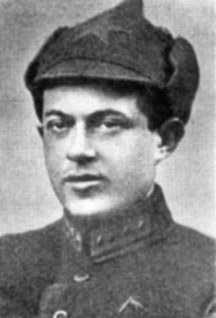 Ukrainian
Jewish Red Army general Iona Yakir
Ukrainian
Jewish Red Army general Iona Yakir In a multi-sided war against Ukrainian bourgeois nationalists led by Petlyura, tsarist White Guards, the German Army and its satrap Hetman Skoropadskyi, and the anarchist peasant army of Makhno, the Bolsheviks prevailed in good part because of their internationalism. They were able to unite the two communist parties, the largely Ukrainian UKP and the heavily Russian KP(b)U, with the left Social Revolutionary/left-nationalist Borotba group. After initially being pushed out by the Whites, the Red Army returned under Ukrainian Jewish general Iona Yakir, whose command included a unit of Chinese immigrant laborers who volunteered to fight the exploiters. The Bolshevik Kiev government was led initially by the Ukrainian left Communist Georgy Pyatakov and then by the Bulgarian-Romanian revolutionary Christian Rakovsky.
The Communists energetically carried forward a policy of “Ukrainization,” fostering Ukrainian culture and language which had been suppressed under tsarism. (This has nothing in common with post-1992 bourgeois policies directed against Russian-speaking Ukrainians.) But in part because of this internationalist heritage, Stalin’s anti-Communist purges hit the Ukrainian Party particularly hard. They began with the Borotbists and went on to include Left Oppositionists and even loyal Stalinists. All were executed – Pyatakov, Rakovsky, Yakir and 80 out of 83 members of the UKP’s central committee “liquidated” while Stalin’s lieutenant Nikita Khrushchev presided. And in August 1940, the greatest Ukrainian communist revolutionary of all, Leon Trotsky, was assassinated by a Stalinist agent.
Meanwhile, Stalinist bureaucratic zigzags led from a policy of enriching the kulaks to forced collectivization of agriculture centered on the Ukraine, traditionally the breadbasket of Russia, leaving over 3 million dead in the ensuing famine. Then in World War II, Stalin resorted to forced transfers of almost 200,000 Crimean Tatars to Central Asia on charges of collaborating with the Nazi invaders. After the war, Poles in western Ukraine were pushed out to resettle in lands to the west seized from Germans, who were likewise expelled en masse. Meanwhile, the Banderaite terrorists of the UPA joined the Nazi SS in massacring Jews and later carried out pogroms against Poles as part of a drive for an ethnically homogenous Ukraine. These forcible population transfers followed the deadly logic of nationalism, which we see again today.
Build a Trotskyist Party! Ukrainian and Russian Workers Unite in Fight for International Socialist Revolution!
The fact that the current upheaval has exacerbated hostilities between Ukrainian and Russian-speakers was by no means inevitable. The origin of the unrest lay in the terrible economic conditions of Ukraine, intensified by the worldwide capitalist economic crisis, and the limitless corruption of the country’s rulers. Nowhere has rule by “oligarchs” been as blatant as in Ukraine, as one set of robber barons after another used the bourgeois state apparatus to gorge themselves on the remnants of the collectivized economy while the working people are left in poverty. By 1999, the Ukrainian economy had plummeted by 50% from Soviet levels. Today average incomes are less than half those in Russia, and far lower in the Ukrainian-speaking west than in the Russian-speaking east and south.
This could have laid the basis for common working-class struggle against all the oligarchs and their politicians. That would have undercut the populist and nationalist appeals of fascists like Svoboda and Pravy Sektor. Instead the so-called Communist Party supported Yanukovich up to the end. Today KPU leader Pyotr Simonenko shamelessly talks of the “deep social discontent and discontent with the rule of Yanukovich and his entourage,” of the “impudent corruption of the Yanukovich clan, nicknamed the ‘Family’,” observing that this was not a class conflict but “a fierce battle between the two factions of the same class of exploiters, the oligarchic bourgeoisie” (Message to KPU cadres, 23 February). Yet KPU legislators supported Yanukovich in the Rada, including voting for the anti-democratic January 16 law banning demonstrations!
The “Communist” Party of Ukraine has a working-class base, winning 13% of the vote in 2012, particularly in the industrial areas of eastern Ukraine, but politically it has defended the interests of elements of the former Stalinist nomenklatura acting in concert with Russian nationalists, including fascistic elements. A “people’s militia” set up in Luhansk included the reactionary Slavic Guard, which denounces the “alien values” of the EU. And on January 24 in Odessa, the KPU joined with Russian Cossacks and “Slavic Unity” to defend the regional administration building. The KPU defended Yanukovich and acted as a Russian nationalist party, aiding the dominance of anti-government protests by Ukrainian ultra-nationalists. For genuine communists, there can be no common action with fascists, either Ukrainian or Russian!
What about tendencies standing to the left of the KPU? The halting attempts to try to form a “left sector” of the Maidan protests, which have been praised by various Western leftists, were a total bust. A “Manifesto: 10 Theses of the Leftist Opposition in Ukraine” (LeftEast website, 14 January) of the Socialist Union “Left Opposition” presented a minimum program of penny-ante reforms that were a reformist fantasy, particularly given the rightist dominance. The “10 Theses” call for a luxury tax and progressive personal income tax (“following Denmark’s example”), workers’ “right to take out loans at the employer’s expense” (“following Portugal’s example”), nationalization of basic industries, “prohibition of offshore capital transfers,” “separation of business and government,” “transition from a presidential to a parliamentary republic,” etc.
Nothing in this wish list would alter in the slightest the capitalist nature of the regime, but Ukraine is no Denmark. Back in the real world, where ultra-rightist forces are in the ascendant, as a result of Maidan Ukraine has a government of fascists and oligarchs. Instead of “dissolution of special forces,” the police are about to become a Gestapo while the Nazi-led Maidan “self-defense guards” are to be transformed into a paramilitary National Guard. And now a March 7 “Left Opposition” statement denounces “Russian aggression in Crimea,” which it claims is “patently imperialistic” – despite strong support from the local Russian-speaking population (labeled “bandit office holders who have become separatists”) – and “aimed against the revolutionary republic” (sic!) At bottom the “Left Opposition” are vulgar Ukrainian nationalists.
Even more blatant are several articles by Russian socialist Ilya Budraitskis, a veteran con artist4 and one-time Moscow leader of the Committee for a Workers International (CWI), who specializes in peddling his wares to Western left and academic audiences. Back in December, Budraitskis wrote an article declaring the Maidan mobilization a “revolution,” even though if victorious it would lead to “a coalition government of rightists and ultra-rightists,” and counseled Ukrainian leftists to embrace “progressive patriotism”! In a subsequent piece, “Is a ‘Left Sector’ Possible?” Budraitskis criticizes local leftists for being too squeamish about embracing the rightist-led protests. His praise of the “direct democracy” in the Maidan is grotesque: as one might expect from a movement dominated by fascists, there was no democratic decision-making.
One of the most illuminating and lucid accounts of the situation in Ukraine comes from an extended interview with a supporter of the revolutionary syndicalist Autonomous Workers Union (AWU) of Kiev on “Maidan and Its Contradictions” (20 February). Denis of the AWU notes that “‘Europe’ was never the main aim of the protesters. Anti-government and anti-Russian sentiments were much stronger,” and the far right groups “now openly state that they don’t care about the EU.” For anyone operating under the illusion that Maidan was not controlled by the rightists, he reports that:
“Another part of the left repetitively tried to join the movement, even after they were repetitively kicked out of it. Some of the ‘euro-enthusiastic’ leftists came to Maidan in November with red flag (instead of blue of the EU), with banners for free healthcare and education, and with feminist slogans. They were brutally attacked by Nazis. Then there was an episode when the far-right attacked the tent of the Confederation of Free Trade Unions of Ukraine near the Maidan…. A mob of Nazis has broken ribs of the trade union activists, tore their tent with knives and stolen their property. The victims hadn’t been doing anything ‘leftist’ per se, but they were members of the left movement, known to their political adversaries, and that was enough.”
There was even a group of supposed anarchists with reactionary, anti-woman, xenophobic positions who tried to unite with the Nazis and threw firebombs at the police together:
“A week ago they, together with some actual leftists who wanted to ‘act,’ decided to form an ‘anarchist sotnia’ [hundred, or centuria] in the Maidan self-defence. In order to do that they were prepared to give an oath to Andriy Parubiy [the fascist-nationalist commander of the storm troops]. But when they formed their ranks to do this, they were met by approximately 150 Svoboda fighters with baseball bats and axes. The fascists accused them of being racially impure and politically irrelevant and forced them out of Maidan.”
After recounting these incidents, Denis of the AWU concludes: “The most reasonable strategy for the left … is to try to build a ‘second front’ against the government as well as the far-right. This should be done from outside of Maidan, not from inside it.” A statement after the overthrow of Yanukovich (“Fifty Shades of Brown,” February 24) notes that “New dictators hasten to take the place of the Party of Regions,” that “in order to stay in power, Yulia Tymoshenko’s team will have to appease the far rightists,” which it has already done. With the prosecutor’s office in the hands of Svoboda and the police controlled by the Right Sector, both of which have had connections to the security forces in the past, the AWU spokesman expects “violence against the left or racist attacks” tolerated (or sponsored) by the new regime.
So unlike many Maidan enthusiasts, the AWU is not blind to the dangers staring it in the face. They also resist the “patriotic” fervor against Russian intervention in Crimea, while calling for respecting the Tatar minority. Yet they sign joint statements with pro-Maidan groups, and do not present a revolutionary program to bring down the new rulers (or even refer to the seizure of power as a coup) nor for working-class struggle against all the oligarchs. And as “revolutionary” syndicalists, AWU does not call for the necessary political instrument to lead that fight, a revolutionary workers party built on the program of Lenin and Trotsky, for international socialist revolution. As a result, it can only be reactive at best, prevented by the limitations of its own program from providing leadership to the masses of working people who desperately need it.
In contrast to the social-democratic and anarchist groups that unsuccessfully sought to join the rightist-dominated Maidan, the leftist Borotba (Struggle) Union has denounced the putschist regime and before that declared (statement, January 27) that the mobilizations were being led by oligarchs, ultra-nationalists/fascists and Western-financed NGOs while outraged citizens were being used as pawns; that a Maidan victory would be a reactionary turn to the right and an even more authoritarian regime; but that leftists could not support the oligarchic Yanukovich government. Since the coup, Borotba has organized an Anti-fascist Resistance Center, supporting self-determination for Crimea as well as eastern and southeastern regions which are holding referendums on autonomy, at the same time as it opposes “fratricidal war.”
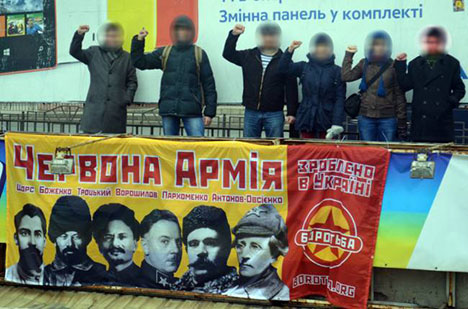 Borotba held banner honoring Red Army commanders
at rally in Donetsk, February 23. (Photo: Borotba)
Borotba held banner honoring Red Army commanders
at rally in Donetsk, February 23. (Photo: Borotba)Borotba defines itself as revolutionary Marxist, anti-capitalist and anti-fascist, standing for internationalism, gender equality, a “socialist alternative” and “revolutionary overthrow of the capitalist system.” It was formed in 2011 as a fusion of the KPU youth, trade-union youth, a Che Guevara youth group and others. Its has a minimum-maximum program characteristic of Stalinists (and pre-World War I social democrats). It is politically eclectic, epitomized in a banner of “legendary Red commanders” from Ukraine, unfurled at a rally in Donetsk on February 23, Soviet Army Day, depicting Leon Trotsky, the founder of the Red Army, next to Kliment Voroshilov, who as Stalin’s henchman played a key role in the bloody “anti-Trotskyite” purges, including signing at least 185 execution lists and denouncing fellow officers!
These are not just historical questions, but directly intersect burning issues in the present historic crisis in Ukraine. While Borotba has participated in important actions such as defending the Lenin statue in Kharkiv and has confronted Russian chauvinists, its political program in this situation bordering on civil war is purely reformist. Its Communiqué No. 3 (26 February), titled “Ukraine On the Brink of Fascist Dictatorship,” calls to guarantee equal rights for all; stop commercialization of health care and education; institute public control over prices for public utilities, essential commodities and public transport; ensure full compliance with labor laws; nationalize the largest companies and institute workers control in state enterprises; eliminate offshore schemes, etc. Nice, but none of this would stop the fascist/oligarchic regime in Kiev.
This program corresponds to the social-democratic “minimum program” and the Stalinist “stagist” conception, in which an “anti-fascist” (or anti-imperialist, anti-feudal, etc.) stage based on bourgeois democracy must precede the struggle for socialist revolution. Yet fascism becomes a mass phenomenon precisely when key sectors of the bourgeoisie come to the conclusion that democratic mechanisms are no longer adequate to preserve its class rule in the face of economic catastrophe or the threat of revolution, and so they unleash mobs of enraged petty-bourgeois to do their dirty work. Neither in Austria and Germany nor in the Spanish Civil War in the 1930s was it possible to stop the fascists with bourgeois-democratic means. To smash the fascist threat it was necessary to mobilize workers in struggle for socialist revolution.
It might be objected that Ukrainian workers are not ready to launch a socialist revolution. Surely not, their consciousness having been destroyed by decades of Stalinist class collaboration and perversion of Marxism. It is precisely in such situations that the Trotskyist transitional program is key to serve as a “bridge” between the present consciousness of the working class and the conquest of power by the proletariat. In the face of the squads of fascist thugs who have been dispatched from Maidan to Odessa, and have popped up in eastern Ukraine, it is necessary to form anti-fascist workers militias rooted in the factories, mines and unions. The militias that have appeared in places like Luhansk and elsewhere do not have a class character, which is vital to mobilizing workers’ power and ensuring internationalist defense of all ethnic, religious and national groups.
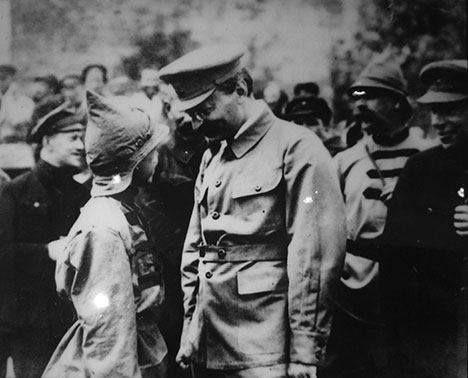 Red
Army commander Leon Trotsky speaking with a young soldier
during the Civil War.
Red
Army commander Leon Trotsky speaking with a young soldier
during the Civil War. (Photo: Museo Casa de León Trotsky)
To recover the robber barons’ ill-gotten gains and counter the Kiev rulers’ appointments of well-known oligarchs as regional governors, calls for nationalization are wholly inadequate: that would simply place control in the hands of whoever is running the Ukrainian capitalist state. Instead there should be a call for workers to seize the plants of all the oligarchs and capitalists and institute workers control. This would buttress worker/peasant/neighborhood committees to control prices and ensure supplies of food and other necessities, and facilitate the establishment of soldiers councils to win over key sections of the battered military ranks and ensure arming of the militias. It would also point the way to workers councils (soviets) that could be the basis for a workers government to expropriate the oligarchs and overthrow capitalist rule altogether.
What’s needed is to organize class struggle against Ukraine’s predatory capitalist rulers and their imperialist backers – the forces that have condemned the population to penury while they wallow in luxury, and which would now impose the dictates of Brussels bureaucrats, New York bankers and the International Monetary Fund. This would enable overcoming hostilities between east and west, between Ukrainian- and Russian-speakers, that have kept the masses divided. Achieving even some transitional demands would set the stage for a protracted fight for power, and even if unsuccessful in the short run an internationalist struggle for such objectives would point the way forward.
The workers of Ukraine have power. The aircraft and tank plants of Kharkiv, the steel mills and coal mines of Donetsk, locomotive works of Luhansk, auto and truck assembly plants of Zaporizhia and Kremenchuk, the bus manufacturing plant of Lviv and heavy industrial plants of Dnipropetrovsk are bastions of proletarian power. If those workers joined in class struggle they could make quick work of bosses who accumulate billions off their labor, swearing devotion to Ukraine while stashing their wealth in Cyprus banks and buying up London real estate. What’s key is leadership, and that requires a revolutionary workers party built on the internationalist program of Lenin and Trotsky, which in 1917-21 enabled the Bolsheviks to overcome far more powerful enemies than some fascist bands and flabby “oligarchs” who will flee as quickly as Yanukovich if their wage slaves revolt.
But that struggle must begin now, before it’s too late. Ukraine is not yet a fascist dictatorship, although getting their hands on state power will greatly strengthen the neo-Nazis and ultra-nationalists. To overcome appeals to Ukrainian nationalism, it is necessary to assiduously defend the democratic, national and linguistic rights of all sectors of the population. As well, such a revolutionary, working-class struggle against fascism requires close collaboration with the workers of Russia and East and West Europe. A free and independent Ukrainian Soviet Republic as envisaged by Trotsky can only be built under the watchword, “Workers of the world unite!” ■
Who Were the Snipers Who Killed Protesters and Police on February 20?
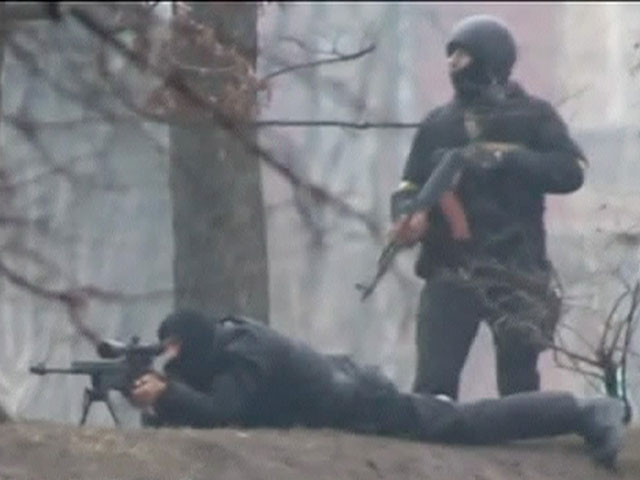
Snipers who shot down protesters and police on February 20. Whoever they are, these are not uniformed cops as claimed by the imperialist governments and media. (Photo: Reuters)
The incident which led to the overthrow of Ukrainian president Yanukovich after almost three months of protests was the carnage on February 20, when 70 or more protesters and 3 policemen were killed, and 27 police hospitalized. The massacre was almost universally blamed on the government, as protest leaders and Western media in unison claimed police did the shooting. The visceral outrage that this slaughter sparked was used by the protest organizers to mobilize a march on parliament the next day. With a caravan reportedly on the way from Lviv in western Ukraine with some 1,500 guns looted from government arsenals, Yanukovich fled. The coup was consummated.
But who was behind the killing is very much in question. By all accounts, many of the victims were shot down by snipers. Asked about this at his March 4 press conference, Russian president Putin answered:
“You know, some people, including those who were recently among the protestors, have expressed the opinion that these were provocateurs from one of the opposition parties…. You and I saw for ourselves when the Berkut fighters [riot police] stood there with their shields and were shot at – and those were not air weapons that were used against them but assault weapons that pierced their shields. That is something we saw for certain. As for who gave the orders – that I do not know.”
Putin’s statement was dismissed out of hand by the Western media. The New York Times (5 March) wrote: “He suggested at one point that it was provocateurs from the opposition posing as snipers — and not government forces — who shot and killed many of those who died, a statement inconsistent with numerous witness accounts.” Others called him “incoherent” and cited his statement as evidence that the Russian president “has lost his mind.”
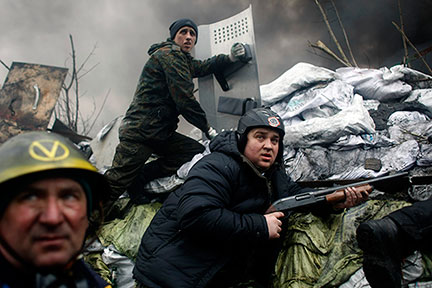 There are numerous photos of armed protesters
in the Maidan on February 20. (Photo:
Marko Drobnjakovic/AP)
There are numerous photos of armed protesters
in the Maidan on February 20. (Photo:
Marko Drobnjakovic/AP)So what did happen on February 20? Even the New York Times (21 February) admitted that the fighting started with the hard-core groups breaking a truce negotiated hours beforehand. “Protesters said they decided to retake the square because they thought the truce, announced about midnight, was a ruse,” declared a picture caption. “The widespread use of firearms in the center of Kiev was a new and ominous phase for the protest movement,” said another under a photo of a protester with a pump-action shotgun. There had already been numerous photos of masked, black-clad Maidan occupiers brandishing pistols. Another article in the same paper, “Converts Join with Militants in Kiev Clash,” reported:
“The Ukrainian authorities and their allies in the Kremlin identify the source of the increase in violence as extremists and terrorists, the young militants of sometimes sinister, far-right political affiliations with ideologies formed in the struggle against Polish and Soviet domination. They have provided much of the front-line muscle in increasingly bloody clashes with the police….
“[T]he murky nature of the opposition gathered in Independence Square, at least on its fringes, is causing problems for the United States and the European Union, which would prefer a neat apposition of peaceful, pro-democracy demonstrators versus the thuggish kleptocracy of President Viktor F. Yanukovych. But that line of thinking often blurs in the streets.”
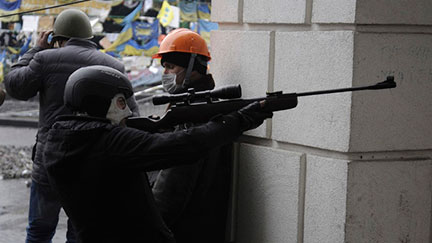 Including
snipers among the protesters in the Maidan on February 20. (Photo: Maks Levin/Reuters)
Including
snipers among the protesters in the Maidan on February 20. (Photo: Maks Levin/Reuters)Some of the firing took place in front-line clashes, but a large number of the dead and wounded, both of protesters and police, were killed by sharpshooters firing from above. The Times reported, “Snipers also opened fire, but it was unclear which side they were on.” In a subsequent interview, photographer Sergey Ponomarev recounted the scene (New York Times, 4 March):
“I was on the front-line barricades on Feb. 20 when protesters suddenly broke through and rushed towards police lines. This was so sudden that the police didn’t manage to form proper lines or barriers to stop the protesters who quickly advanced up the street. They were almost in front of the retreating police vehicles and water cannon trucks….
“Then I went downstairs to follow protesters – just a few minutes before snipers started to shoot protesters from a small tower nearby…. I didn’t understand why this happened, why the snipers are shooting towards the protesters who had only clubs and shields.”
While several accounts claimed that the snipers, seen at a distance, were wearing police uniforms, they also describe the shooters as “dressed all in black, their faces hidden by balaclavas” (The Independent [London], 21 February). But that description also fits many of the fascists and rightist nationalists who were among the hard-core Maidan occupiers.
Yanukovich insists he gave no order to fire on the protesters. Several police officials also say no such order was given, and that no rifles were issued to the police. Instead there are numerous photos and video of police with only shields and riot clubs being overpowered by demonstrators tossing firebombs and firing explosive devices. And there is the question of cui bono, who benefits? Why would regime supporters single out women, bystanders and medics as targets, which would only inflame protesters and set public opinion against the government? Blogger Dmitry Orlov summed up these incongruities in a March 1 posting, “Reichstag Fire in Kiev,” noting the parallel to the February 1933 event, blamed on the Communists but likely carried out by the fascists, which sent Nazi vote totals soaring and sealed Hitler’s assumption of power.
The London Guardian (21 February) quoted Dr. Olga Bohomolets saying, “What is happening right now in Ukraine is criminal and anti-human. All the people killed here had no guns or arms.” The doctor was the coordinator of the medical units in the Maidan, is the head of Kiev’s dermatology and cosmetology institute and was President Viktor Yushchenko’s personal physician after his dioxin poisoning in 2004. On February 26, Olga Bohomolets was appointed deputy prime minister for humanitarian issues in the post-coup “government.” But several hours later she turned down the job, apparently without explanation. Now we may know part of the reason why.
On March 5, the RT (Russia Today) Internet site posted an article and audio file of a leaked conversation between Estonian foreign minister Urmas Paet, who had just returned from Kiev on February 25, and Catherine Ashton, the European Union foreign affairs chief. In that phone call, Paet reports:
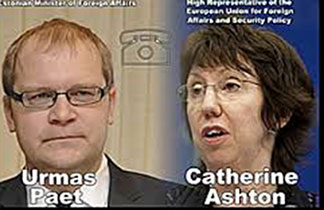
“In fact, and what was quite disturbing, the same Olga [Boholomets] told as well that all evidence shows, that the people who were killed by snipers, from both sides, among policemen and people from the streets, that they were the same snipers killing people from both sides.
“She also showed me some photos, and that as a medical doctor she can say it is the same handwriting, the same type of bullets. And it’s really disturbing that now the new coalition, that they don’t want to investigate what exactly happened. So that there is now stronger and stronger understanding that behind the snipers, it was not Yanukovich, but it was somebody from the new coalition.” [our emphasis]
Paet added that “this already discredits from the very beginning this new coalition.” Interestingly, the day before this phone call was leaked, the mayor of Estonia’s capital Talinn, Edgar Savissaar, was quoted in a local newspaper saying that “the self-proclaimed Ukrainian government was put into power by people with baseball bats,” and that “it lacks both credentials and the capacity to solve the crisis in the country.”
So here we have the prime minister of one of the Baltic Republics that broke away from the Soviet Union as it was coming apart telling the head of EU foreign policy that the doctor who was in charge of medical teams at the Maidan, who was named deputy prime minister, told him that the same snipers killed people from both sides, and that there is “stronger and stronger understanding that behind the snipers, it was not Yanukovich, but it was somebody from the new coalition.” Naturally, not a word of this was reported in the Western press, at least until now. Yet rather than more and more people “losing their minds,” including those in a position to know and with no reason to slander the occupiers, there is more and more reason to suspect that the bulk of the killings were carried out by provocateurs from the Maidan.
- 1. For this and more about Svoboda’s adulation of fascism, see Per Anders Rudling, “The Return of the Ukrainian Far Right,” in Ruth Wodak and John Richardson, Analyzing Fascist Discourse (2013).
- 2. In our article, “U.S. Sponsored Coup d’État in Ukraine,” we quoted from The Grand Chessboard where Brzezinski spells this out:
- “Ukraine, Azerbaijan, South Korea, Turkey and Iran
play the role of critically important geopolitical
pivots…
“Ukraine, a new and important space on the Eurasian chessboard is a geopolitical pivot because its very existence as an independent country helps to transform Russia. Without Ukraine, Russia ceases to be a Eurasian empire….
“However, if Moscow regains control over Ukraine, with its 52 million people and major resources as well as access to the Black Sea, Russia automatically again regains the wherewithal to become a powerful imperial state, spanning Europe and Asia….
“Neither the West nor Russia can afford to lose Ukraine to its geostrategic and geoeconomic adversary.” - 3.The Clinton connection goes even deeper. One of oligarch Pinchuk’s confidants in the corridors of power in Washington is Melanne Verveer, a Ukrainian American who was Hillary’s chief of staff in the White House and more recently ambassador at large for women’s issues. Chelsea is married to a Ukrainian American, and as the Wall Street Journal noted, it was not some right-wing Republican but Democratic front-runner Hillary who compared Putin to Hitler. The Clintons are tracked on Ukraine.
- 4. See our article, “A Band of Political Impostors and Swindlers in Ukraine,” The Internationalist No. 17, October-November 2003.
